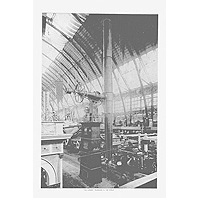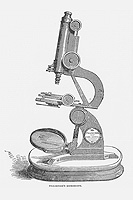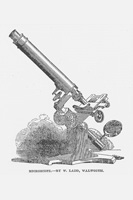Telescope and Microscope
Telescope
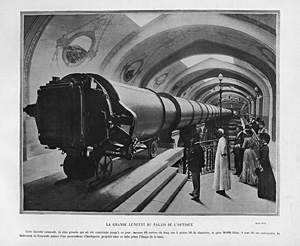 This is an image of the largest-ever refracting telescope exhibited in the pavilion named Palais de l'Optique at the fifth Paris International Exposition of 1900. Its focal length was 55 m, while the lens diameter was 125 cm. With its position fixed, the telescope used a Foucault siderostat, a mirror invented by J. B. L. Foucault. This was designed to guide light from any direction to the telescope. Visitors to the exposition were able to make actual astronomical observations, forming a long line of visitors from evening to the middle of the night.
This is an image of the largest-ever refracting telescope exhibited in the pavilion named Palais de l'Optique at the fifth Paris International Exposition of 1900. Its focal length was 55 m, while the lens diameter was 125 cm. With its position fixed, the telescope used a Foucault siderostat, a mirror invented by J. B. L. Foucault. This was designed to guide light from any direction to the telescope. Visitors to the exposition were able to make actual astronomical observations, forming a long line of visitors from evening to the middle of the night.
It is said that the first telescope was the refracting long-distance observation instrument created in 1608 by H. Lipperhey, a Dutch optician. The instrument featured the combination of a crystal convex objective lens and a concave eyepiece lens. The next summer, hearing the rumor of Lipperhey's invention, G. Galilei also successfully produced such an instrument and made various discoveries, which is why the combination method of convex and concave lenses is called Galilei's method.
In 1611, J. Kepler invented a telescope with two convex lenses. Unlike Galilei's method, Kepler's method provided inverted images, but it had an advantage in that the field of view was not narrowed even when the magnification was increased. In 1655, the Huygens brothers of the Netherlands developed a new lens grinding method. They identified the shape of the rings of Saturn and discovered its satellite Titan using a 3.3 m long telescope with their new lens.
Refracting telescopes had an optical defect of chromatic aberration, in which images were blurred with their fringes colored. In 1668, I. Newton of England created the first reflecting telescope with a concave mirror as a replacement of an objective lens, successfully correcting the defect.
Since the maximum diameter of a refracting telescope lens that could be made in those days was 10 cm, to further increase magnification, a reflecting telescope with a larger caliber needed to be created. An example of such a telescope was the Nasmyth reflecting telescope created in 1851 by J. Nasmyth, (who was renowned for inventing a steam hammer).
Subsequently, refracting telescopes began to grow to huge sizes, along with the invention of achromatic lenses free of chromatic aberration due to a combination of lenses with different refractive indexes, as well as the development of colorless, transparent optical glasses. At the first Paris International Exposition of 1855, a 74 cm caliber optical glass material was exhibited by Chance Brothers & Co. of England. At the Chicago International Exposition of 1893, a 101.6 cm caliber refracting telescope created by A. G. Clark was exhibited. This refracting telescope today resides in the Yerkes Observatory. This is the largest equatorial refracting telescope (that can track stars according to their diurnal motion) that is still in actual use. The 125 cm caliber refracting telescope shown in the above picture was the largest ever (although it was subsequently dismantled).
However, since larger refracting telescopes required longer cylinders, the mainstream of large telescopes was shifted to reflecting telescopes in the 20th century.
Microscope
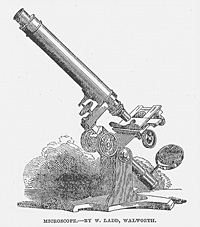 This is an image of a microscope exhibited at the first London International Exposition of 1851. Little difference can be found between this exhibit and microscopes today.
This is an image of a microscope exhibited at the first London International Exposition of 1851. Little difference can be found between this exhibit and microscopes today.
It is said that the origin of microscopes began with Z. Jansen and his father, H. Jansen, both Dutch opticians. Around 1590, they put lenses on the ends of a cylinder and observed tiny things using the two convex lenses. However, the performance was poor, making it difficult to call the instrument a scientific tool for magnifying images.
In 1665, R. Hook created a compound microscope with a combination of an objective lens and an eyepiece lens, and published Micrographia. In this book, he presented how to make the compound microscope graphically and explained how to use this microscope. Also, he achieved a biological breakthrough: the discovery of cells of living things. Meanwhile, in 1683, A. V. Leeuwenhoeck invented a simplex microscope with a high magnification, featuring a sphere lens. Although this invention led to the discovery of bacteria, the microscope was difficult for users, other than himself, to operate.
On the other hand, the compound microscope with two types of lens, objective and eyepiece types, had an optical defect similar to that of telescopes: chromatic aberration. This defect remained uncorrected for a long period of time. However, it was finally settled through the invention of achromatic lenses and the discovery of a solution on a spherical aberration, as well as the invention of an achromatic microscope in 1829 by J. J. Lister of England.
The above image depicts a compound microscope to which such improvements were made. At the London International Exposition of 1851, several exhibitors displayed such a microscope. At the Philadelphia International Exposition of 1876, Bausch & Lomb, still renowned for its contact lens products (although it was established as an optician's shop), exhibited microscopes, winning several awards.
Telescope (9 images)
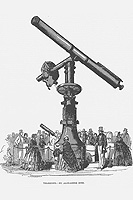 |
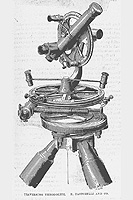 |
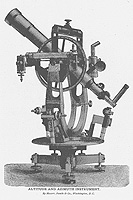 |
| Telescope Exhibited by Alexander Ross | Traversing Theodolite Improved by F. Pastorelli | Fauthe's Altitude and Azimuth Instrument |
- References:
Kobayashi, Yoshio.: Sekai no kenbikyo no rekishi (Kobayashi Yoshio, 1980) <MC111-23>
Tanaka, Shinichi.: Kenbikyo no rekishi (Kyushu bunko shuppansha, 1979) <MC111-12>
Yoshida, Shotaro.: Boenkyo hattatsushi 2 v. (Seibundo shinkosha, 1994) <MB51-E27>
Yoshida, Shotaro.: Kyodai boenkyo eno michi (Shokabo, 1995) <MB51-G3>

